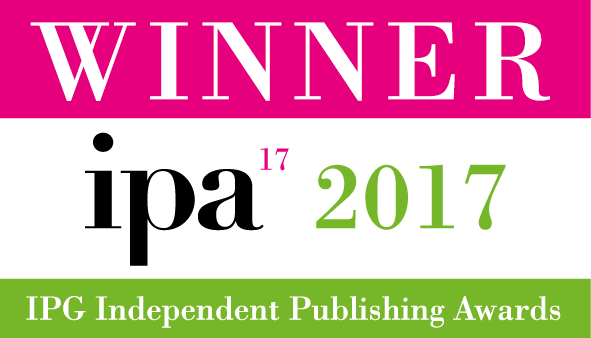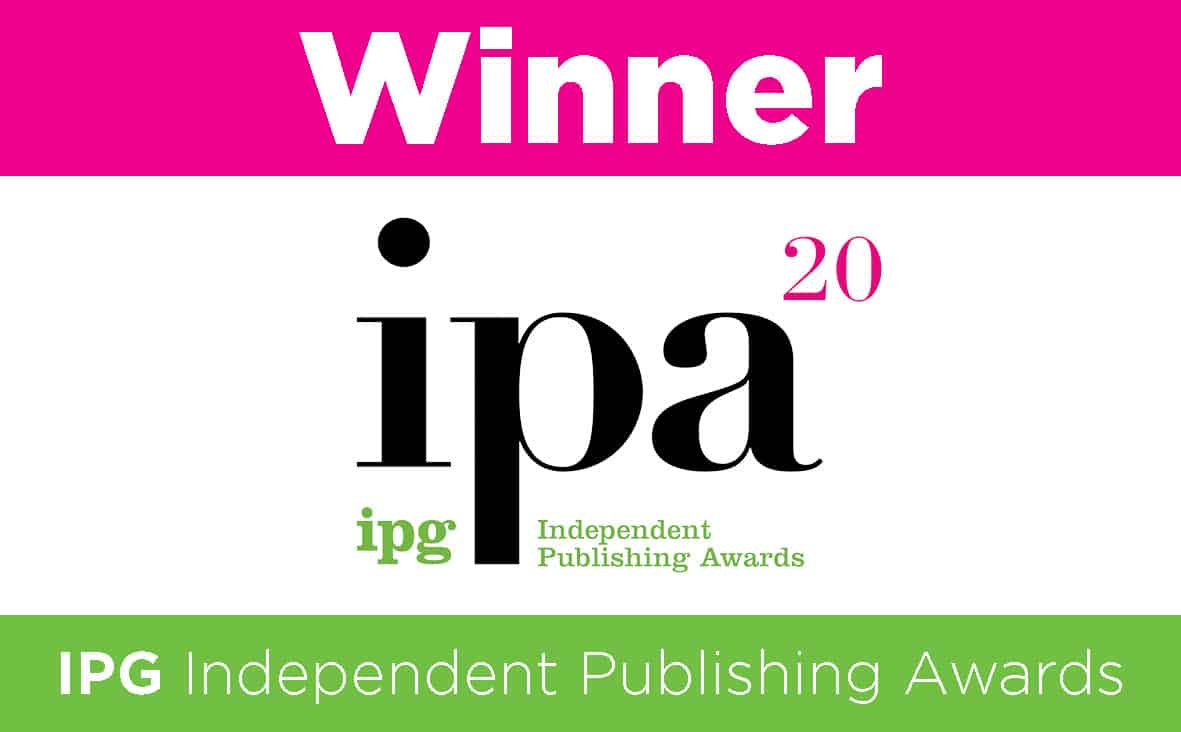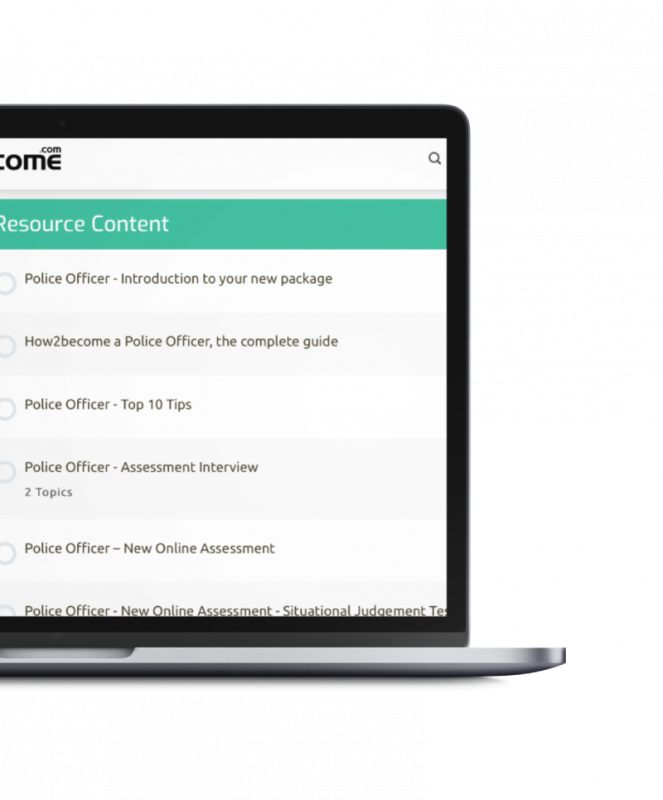
IELTS ACADEMIC WRITING 8+
How to write high-scoring 8+ answers for the IELTS exam. Packed full of examples, practice questions and top tips.
4.9/5 Rating | 1,000+ Reviews ![]()
Training That Works
Discover insider secrets and a masterclass of testing practice material that has helped 100s of candidates pass their assessment tests.
Unlock Your Potential
Whether you’re just starting out or you know what to expect, you will get access to 100s of questions, with solutions that will catapult your chances of success.
Powerful Resources
Get instant access to the material right now which includes how to write high-scoring 8+ answers for the IELTS exam.
IELTS ACADEMIC WRITING 8+
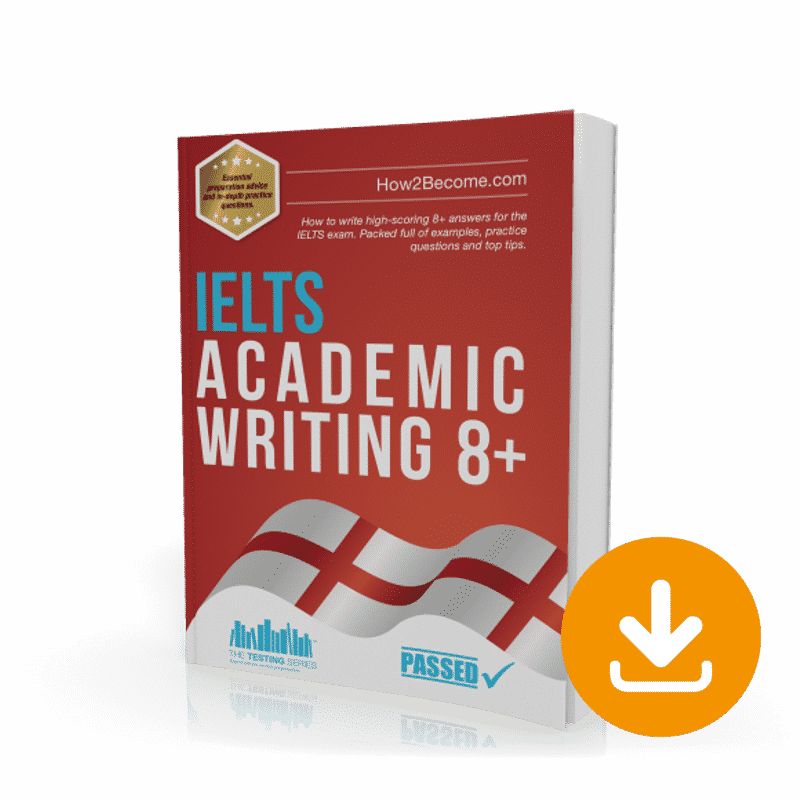
IELTS ACADEMIC WRITING
The IELTS Academic writing assessment is a comprehensive test of your writing skills. Just like the reading assessment, the exercises have been deliberately chosen to be appropriate for people applying for a university course or wanting professional registration.
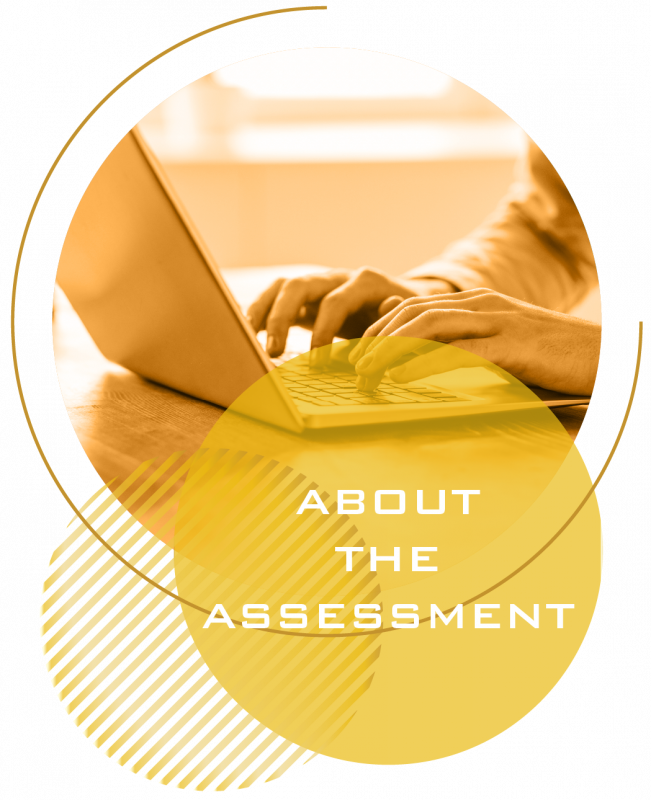
ABOUT THE WRITING ASSESSMENT
The test will last for 60 minutes, and will assess elements such as:
- Writing clearly and concisely.
- Accurately summarise data.
- Your ability to describe.
- Ability to explain.
- Identifying arguments, and responding to them.
- Your ability to write formally.
- Use of language to persuade and inform.
- Grasp of grammar, spelling and punctuation.
There are a total of two tasks in the IELTS Academic writing assessment. The second task is the most important in terms of your writing band score, contributing to double that of task 1.
IELTS Academic, Task 1
In this task, you will be given a graph, table or chart. Your job is to look at the image and then summarise or explain the information that’s being presented. You might also be given a diagram of a machine, or a device, and then asked to explain how it functions and how it works.
The main aim of the assessment is to see how well you can identify important information and trends/patterns, whilst giving an overview of said information in an accurate and academic/formal style. Your main priority should be to include the most important/relevant aspects of the image in front of you. You should try to include minor details if you can, but you will score higher if you focus on the more important elements of the image.
YOU WILL BE GIVEN 20 MINUTES TO COMPLETE THIS TASK.
The aim should be to write 150 words in total. If you write any less than this then you will be penalised. You will not lose marks for exceeding the word count, but you should not spend any longer than 20 minutes on this task.
You will also be penalised if you go off topic at any point during your written response, or you fail to adhere to basic requirements, such as sentence structure, grammar, spelling and punctuation. Ensure you write in full and clear sentences, do not use bullet points or short-hand text. When taking the test, you’ll be provided with an answer booklet in which to write your responses.
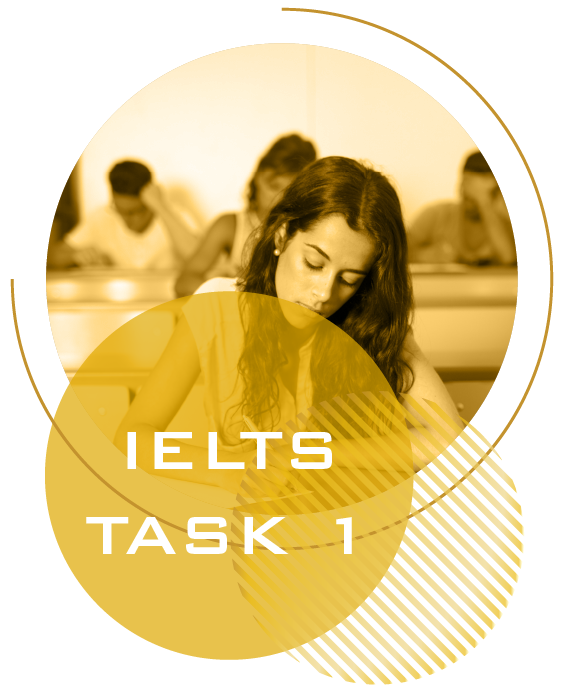
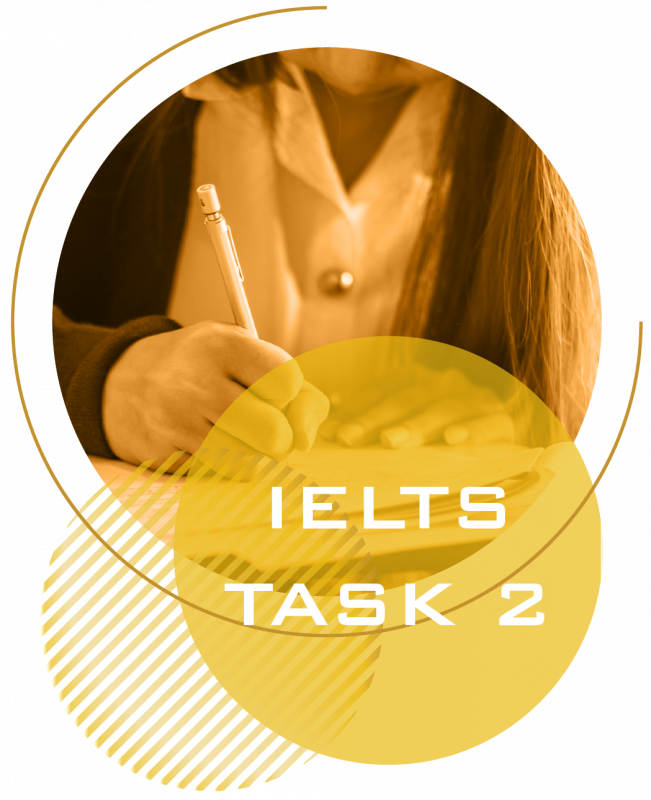
IETLS Academic, Task 2
In this task, you will be given a topic and then asked to write about it in an academic/formal style. The topic will be given to you in the form of a prompt. For example, you might be given a statement which reads, ‘Zoos are immoral and should be banned.’ You’ll then need to respond to this statement, either arguing for or against, with detailed analysis on why you believe what you believe.
You should try to support your answer with evidence, and you are allowed to use examples based on your own personal experience. You must make sure that you focus on the statement in the question. For example, if the statement reads, ‘Zoos are immoral, they should be banned,’ then you need to focus your answer on zoos, not just on lions, or whatever your favourite animal is. While you could use the plight of some animals kept within zoos to strengthen your argument, this should not be the main focus of your argument.
THE MINIMUM WORD COUNT FOR THIS EXERCISE IS 250 WORDS, AND YOU WILL HAVE 40 MINUTES TO COMPLETE THE ASSESSMENT.
Again, falling under the word count will result in you being penalised. The marks for task 2 are twice that of task 1, meaning that failure to complete this exercise will greatly harm your chances of scoring highly.
During this assessment, the main elements that are being tested are in relation to the fluency of your writing and vocabulary. You are also being tested on how well your response is structured, how well it uses persuasive language, and how well it cites information and ideas. Basically, you need to put together a coherent and logical response, paying attention to grammar, spelling and punctuation, whilst addressing the main statement from the question.

PASS YOUR IELTS

Absolutely full to the brim with incredible tips, tricks and strategies for achieving 8+ in the IELTS Academic writing task, this guide is the ultimate resource for aspiring IELTS test takers! Also containing a detailed breakdown of both tasks 1 and 2, even more sample questions and answers, our book is sure to improve your scores TODAY!
This download guide contains advice on:
- Every single element of the IELTS Academic writing examination!
- Learn how to maximise your scores, and achieve an 8+.
- How to demonstrate linguistic prowess, through fantastic written responses.
Sample IELTS Academic Writing Questions
To help you get a better understanding of what the IELTS assessment involves, let’s take a quick look at a few sample questions.
FREE | 2 Questions
IELTS Practice Questions
Task 2 will consist of the following:
You’ll be given a statement or question, and then asked to write 250 words discussing this in essay format, using formal language. You will be marked on your ability to argue for/against in a persuasive fashion, using evidence, and examples based on your own personal experience too.
You’ll have a total of 40 minutes to complete the assessment. Again, falling under the word count will result in you being penalised. The marks for task 2 are twice that of task 1, meaning that failure to complete this exercise will greatly harm your chances of scoring highly.
During this assessment, the main elements that are being tested are in relation to the fluency of your writing and vocabulary. You are also being tested on how well your response is structured, how well it uses persuasive language, and how well it cites information and ideas. Basically, you need to put together a coherent and logical response, paying attention to grammar, spelling and punctuation, whilst addressing the main statement from the question.
‘Technology is harmful to human interaction.’
ANSWERS
Sometimes, looking at a graph can seem quite intimidating. There’s a lot of information to take in, and it can be quite hard to make sense of it all. The thing to do here is to stay composed. Don’t panic and let the information overwhelm you. Take a moment just to look at everything in a calm and logical fashion, and work out exactly what the graph is showing. Once you’ve done that, your answer shouldn’t be too difficult. All you have to do is summarise exactly what you see in the graph, in 150 words or more.
So, how should we look at the above graph? The first thing that should stand out for you is that the graph shows the relationship between the months of the year and the number of shoplifting incidents that occurred, in the countries of Scotland, Ireland and England. Your first line should explain this.
FOR EXAMPLE:
‘The graph shows a correlation between the time of the year and the number of shoplifting incidents that occur in the countries of Scotland, Ireland and England.’
Now that you’ve summarised the main point of the graph, you can move onto the actual data. When we look at this graph, we can clearly see that there are more shoplifting incidents occurring from January-March, and October-December, than there are from April-June and July-September. Therefore, logic would dictate that more shoplifting incidents are occurring during the colder months of the year.
Once you’ve established this, you just need to work out the numbers behind the increase/decrease, and then summarise this.
LIKE SO:
‘By looking at this graph, we can see a clear indication that more shoplifting incidents occur during the ‘colder’ months of the year than during the hotter months. To demonstrate this, the graph shows that from January to March (in all three countries) there were 95 shoplifting incidents in total. This was followed by a marked decrease, with only 135 incidents occurring over the next 6 months. It is worth noting that there was an increase in shoplifting incidents from July till September, compared to April till June, but this was quite a minor leap.’
In the above we’ve covered the first 9 months of the year. Now we can close our summary by detailing the final 3 months of the year:
‘Following this, and moving into the Autumn, we saw a large increase in the number of incidents – with 135 incidents occurring over the next 3 months, from October till December.’
If we put this altogether, we have a concise, accurate and 150+ word summary of the graph in question.
FINAL STRUCTURED ANSWER:
‘The graph shows a correlation between the time of the year and the number of shoplifting incidents that occur in the countries of Scotland, Ireland and England. By looking at this graph, we can see a clear indication that more shoplifting incidents occur during the ‘colder’ months of the year than during the hotter months. To demonstrate this, the graph shows that from January to March (in all three countries) there were 95 shoplifting incidents in total. This was followed by a marked decrease, with only 135 incidents occurring over the next 6 months. It is worth noting that there was an increase in shoplifting incidents from July till September, compared to April till June, but this was quite a minor leap.
Following this, and moving into the Autumn, we saw a large increase in the number of incidents – with 135 incidents occurring over the next 3 months, from October till December.’
If you’ve ever written an essay, you might be familiar with the general structure of how to approach a question like this. However, in the IELTS Task 2, you have a limited amount of time and words. This means that you need to be short and concise with what you are saying. In a normal essay, you might take the time to acknowledge counter arguments and alternative points of view. Since you’ve only got 250 words (or slightly more) for this task, it’s advised that you focus on just arguing for or against the topic. While you can of course make passing reference to other points of view, keep these brief, and above all stay focused on the argument that you are trying to make. Remember that you are trying to be persuasive, and highlight that your point of view is the correct one.
There are two structural approaches that you can take to an essay, and in this book we have provided you with examples of both. Below is an example of how to write in plain and simple language:
This aptly named way of writing an essay is exactly what it sounds like. You start out by responding to the statement.
FOR EXAMPLE:
‘I agree with the statement. I believe that technology is harmful to human interaction. The reasons that I believe this are as follows.’
Here you have clearly laid out your viewpoint, and now you can move onto the main body of the essay. The difference between this and a longer essay is again, the time and number of words that you have. Whilst in a longer essay you might start out by talking about different forms of technology, definitions of the word harmful, and other such speculation – in the IELTS essay it’s better to get straight to the point. 250 words is not a huge amount.
Following this, the main body of the essay should be pretty simple. Write one to three reasons why you agree (or disagree) with the statement.
FOR EXAMPLE:
‘Firstly, I believe that…’
‘Secondly, we must consider that…’
‘Thirdly, it is important to recognise that…’
Finally, we have the conclusion. In your conclusion, above all you should basically summarise the main point of the essay. For example: ‘In conclusion, I feel that technology is harmful to human interaction, because it has a sustained impact on the way we behave face-to-face.’

Scoring Criteria
Essential information about how you will be assessed during the IELTS writing assessment.
UP-TO-DATE FOR 2025
All exercises have been verified by our assessment panel experts for the 2025 tests.
PRACTICE SAMPLE TEST QUESTIONS
Step-by-step information on how to pass the IELTS writing assessment.
FULLY-WORKED SOLUTIONS
Solutions for all questions so you can be confident in learning and improving your score.
INSIDER SECRETS
Insider tips on how to answer the questions and a breakdown on how you will be scored.
SCORE-BOOSTING STRATEGIES
Get ahead of the competition with unique and proven strategies 16 years in the making.
Customer Success Stories
Having helped 1,000s of people pass their assessment tests for over 16 years, it is no wonder our customers love us…

Perfect way to prepare. Doing these tests has helped me get through the first hurdle.

The book has plenty of questions and allows you opportunities to practice thoroughly.

Useful when needed!

This is a really good book. Even gives clear understanding of how answers are given.

WHAT’S INCLUDED IN YOUR DOWNLOAD?
Complete guidance to ensure you pass the assessment tests.
- Step-by-step guidance on how to answer each question type.
- Quick tips to improve your writing and boost your score.
- Example answers with detailed explanations to help you learn.
- Packed full of practice questions and answers.
- How you will be assessed, and what you must do in order to score highly.
- How to boost your score, using quick and concise strategies.

PLUS…BONUS!

BONUS
PLUS…30-Day Free Subscription Trial To The Online Life in the UK Tests Testing Platform!
As well as life-time access to the IELTS Writing 8+ download, this product also includes a 30-day free trial to Online Life in the UK Tests Testing Platform (usually £9.99 + vat per month).

- 100s of additional practice questions to help boost your scores!
- Practice all of the test questions under timed conditions using our online testing suite.
- Instant online access.
- Compatible on mobiles, tablets and computers.
- Scores are tracked so you can focus on areas that need improvement.
Important: This powerful free trial costs £9.99 + vat every month for everyone else! You will get unrestricted access to all of the quick-win strategies to give you the advantage right away.
Worth £9.99, Yours FREE for 30-days*
*We want you to know: This is a subscription service that is charged at just £5.95 + vat per month after the 30-day trial expires. No minimum term. If you cancel before the 30-day trial ends, you will not be charged. Please see our terms for full details.
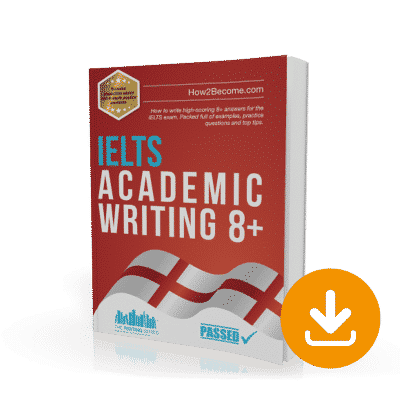
✓ 30-Day Money-back Guarantee
Did you know? All orders with How2Become are protected by our 30-day money-back guarantee. What ever the reason…or no reason at all…you can have your money back if this resource isn’t right for you (see our terms for full details).
WHY BUY WITH HOW2BECOME?
CREATED BY THE EXPERTS
PROVEN TRAINING
EXCLUSIVE FREE BONUSES
Firstly, these guides are created by us and our team of experts – we have all the answers to your questions and will help you succeed (like we’ve been doing for the last 16 years), we update our material frequently and you can contact us at any time with any questions you have.
Secondly, we provide exclusive bonuses with all our products that you won’t find anywhere else. These bonuses include free guides, powerful online testing suites and more!
Finally, our guides and training just work. Take a look at our TrustPilot page where you will see our rating of 4.9/5. There, our customers share their positive buying experiences and more importantly the time-saving success our resources have given them (hint: they passed their assessment).
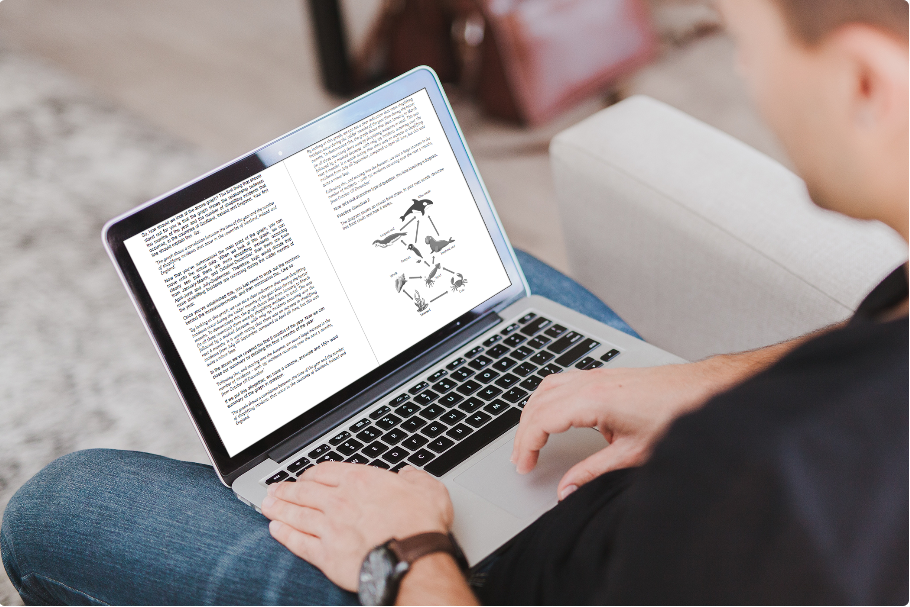
Learn how to PASS YOUR ASSESSMENT
We’ve helped 1,000s of aspiring applicants in their journey to succeed in a new career. Trust the UK’s #1 careers and education specialists to help you secure your role.
Get instant access »“Great variety of question types, exposes areas of weakness and gives you the means to improve. Clear and concise. Confidence builder. Great practice!”









